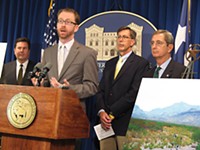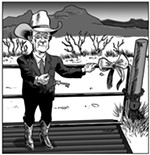Keeping Our Land Public
How hard can it be?
By Richard Whittaker, Fri., Sept. 28, 2007

It started as a minor administrative error. The General Land Office was selling off the Christmas Mountains in Brewster County, a stretch of undeveloped land in far West Texas, with the proceeds going to the School Land Board. But on the sale map the boundary line was drawn half a mile within the real limits, and so on Sept. 18, the bidding process had to start afresh. Now it has become an argument over how the GLO deals with donated wilderness.
In 1991, the Virginia-based Conservation Fund gave Christmas Mountains Ranch to the state. But it was no festive gift: 9,270 acres of mountain and scrub, mostly unreachable except on foot, and so covered in salt cedar and other invasive plants that it was unlivable for most species. "The land was parked at the GLO," said Texas Land Commissioner Jerry Patterson, "and when I say parked, it was put there to ensure it wasn't subdivided or developed." The land came with significant easements built into the deed, intended to keep it as pristine as possible. Patterson said that while the land was publicly owned, "it was never intended to be a public area. It was intended to be a preservation area. Preservation and parks are mutually exclusive."
The decision to sell the land now, he added, was part of an ongoing inventory process and not market-driven. "Half a million dollars for an outfit that makes half a billion a year is not that much money," he said. However, according to Environment Texas' Legislative Director Luke Metzger, there should be no sale, as the Conservation Fund meant for the land to stay in public hands. "It's a slap in the face to the original landowners and makes Texas look bad," he said.
In the first round, the GLO received six bids from private firms and individuals around the country, and the two largest both came with lengthy land-management and conservation plans. Southwestern Holdings Inc. of Houston offered $509,828 and proposed amalgamating the land with nearby Cibolo Creek Ranch, which it owns and partially runs as a practical land-restoration laboratory. The company proposed simple renovations and brush clearance, intended to increase deer, elk, and quail populations and hunting when animal head counts are higher. The largest bid, $652,000 from AT Land Co., proposed turning the property into a natural wildlife reserve for ecological, geological, and historical academic researchers, with hunting only for population control.
"It would be a travesty to continue the status quo, so we're trying to balance preservation and restoration and limited public access that's appropriate to these goals," said Patterson. "Selling it to a private party that can work with the deed restrictions and easements is the best way of doing it." Which raises the question of why the federal government or the state of Texas couldn't manage the land.
The Conservation Fund originally offered the land to the National Park Service in 1991, to add to the adjacent Big Bend National Park. However, according to James Doyle, legislative specialist with the NPS Intermountain Region, the offer was turned down, "because it would have required legislation by Congress to add that much land." The GLO offered NPS the land in 2004, but it again declined, saying the easements should provide sufficient protections. Patterson said he would not reoffer NPS the land because the GLO had restrictions of its own. "I would not sell it to them unless they allowed limited public access and appropriate public hunting, and national parks are off-limits to hunting," he said.
This still leaves the state of Texas. In 2005, the GLO offered the land to the Texas Parks and Wildlife Department, but they declined. Still, Patterson has not ruled out a sale to TPWD. "I spoke to them as recently as [Sept. 18]," he said, "and told them 'I can offer you a good deal on it,' but they don't want it, because it's not good for a park." According to Scott Boruff, chief operating officer for TPWD, the agency's hands are tied. Six years ago, the underfunded department was mandated by the legislature to draw up a long-term strategic plan and make a list of priorities. "We have 440,000 acres out in far West Texas that we have trouble managing because of funding," said Boruff, "so the decision was made to not take on more land there. The Legislature had not given us any appropriations anywhere in the state of Texas, and we had no cash available to buy it."
For Environment Texas, this is another example of privatizing the small portion of Texas that is publicly held. "We see the sale as part of a pattern of poor land management by the GLO, emphasizing profits over protecting our natural heritage," Metzger said. "Only 5 percent of Texas is public land. All the polls show people don't think that's enough, so this is a step in the wrong direction."
Got something to say on the subject? Send a letter to the editor.










